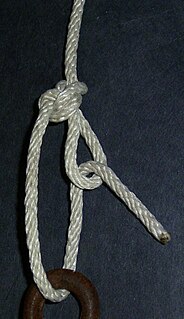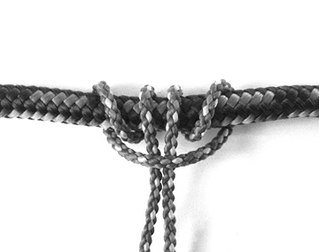This page is based on this
Wikipedia article Text is available under the
CC BY-SA 4.0 license; additional terms may apply.
Images, videos and audio are available under their respective licenses.

A knot is an intentional complication in cordage which may be useful or decorative. Practical knots may be classified as hitches, bends, splices, or knots. A hitch fastens a rope to another object; a bend unites two rope ends; a splice is a multi-strand bend or loop. A knot in the strictest sense serves as a stopper or knob at the end of a rope to keep that end from slipping through a grommet or eye. Knots have excited interest since ancient times for their practical uses, as well as their topological intricacy, studied in the area of mathematics known as knot theory.

The bowline is an ancient and simple knot used to form a fixed "eye" at the end of a rope. It has the virtues of being both easy to tie and untie; most notably, it is easy to untie after being subjected to a load. The bowline is sometimes referred to as King of the knots because of its importance. Along with the sheet bend and the clove hitch, the bowline is often considered one of the most essential knots.

The constrictor knot is one of the most effective binding knots. Simple and secure, it is a harsh knot that can be difficult or impossible to untie once tightened. It is made similarly to a clove hitch but with one end passed under the other, forming an overhand knot under a riding turn. The double constrictor knot is an even more robust variation that features two riding turns.

A shank is a type of knot that is used to shorten a rope or take up slack, such as the sheepshank. The sheepshank knot is not stable. It will fall apart under too much load or too little load.

The trucker's hitch is a compound knot commonly used for securing loads on trucks or trailers. This general arrangement, using loops and turns in the rope itself to form a crude block and tackle, has long been used to tension lines and is known by multiple names. Knot author Geoffrey Budworth claims the knot can be traced back to the days when carters and hawkers used horse-drawn conveyances to move their wares from place to place.

The marlinespike hitch is a temporary knot used to attach a rod to a rope in order to form a handle. This allows more tension than could be produced comfortably by gripping the rope with the hands alone. It is useful when tightening knots and for other purposes in ropework.

The figure-eight knot or figure-of-eight knot is a type of stopper knot. It is very important in both sailing and rock climbing as a method of stopping ropes from running out of retaining devices. Like the overhand knot, which will jam under strain, often requiring the rope to be cut, the figure-of-eight will also jam, but is usually more easily undone than the overhand knot.
The figure-eight or figure-of-eight knot is also called the Flemish knot. The name figure-of-eight knot appears in Lever's Sheet Anchor; or, a Key to Rigging. The word "of" is nowadays usually omitted. The knot is the sailor's common single-strand stopper knot and is tied in the ends of tackle falls and running rigging, unless the latter is fitted with monkey's tails. It is used about ship wherever a temporary stopper knot is required. The figure-eight is much easier to untie than the overhand, it does not have the same tendency to jam and so injure the fiber, and is larger, stronger, and equally secure.

The packer's knot is a binding knot which is easily pulled taut and quickly locked in position. It is most often made in small line or string, such as that used for hand baling, parcel tying, and binding roasts. This latter use, and its general form, make it a member of a class of similar knots known as butcher's knots. The knot is commonly taught to Guides and Scouts, and those in similar organizations as a basic binding knot.

A Zeppelin bend is a general-purpose bend knot. It is a secure, easily tied, and jam-resistant way to connect two ropes. Though its simplicity and security may be matched by other bends, it is unique in the ease with which it is untied, even after heavy loading, by pulling the opposing bridges away from each other.

A blood knot is most usefully employed for joining sections of monofilament nylon line while maintaining a high portion of the line's inherent strength. Other knots used for this purpose can cause a substantial loss of strength. In fly fishing, this serves to build a leader of gradually decreasing diameter with the castable fly line attached at the large diameter end and the fly or hook at the small diameter end. The principal drawback to the blood knot is the dexterity required to tie it. It is also likely to jam, which is not a concern in fishing line, which is no great loss to cut, but may be a concern in normal rope. "Blood knot" may refer to, "a double overhand knot tied in a cat-o'-nine-tails."
The barrel knot, called blood knot by Keith Rollo, is the best bend there is for small, stiff or slippery line. The ends may be trimmed short and the knot offers the least resistance possible when drawn through water.

The draw hitch is a quick-release draw loop knot used for temporarily securing a load that will need to be released easily and cleanly. The hitch can be untied with a tug of the working end, even when under tension. The highwayman's hitch can be tied in the middle of a rope, and so the working end does not need to be passed around the anchor when tying or releasing.

A stopper knot is a knot that creates a fixed thicker point on an otherwise-uniform thickness rope for the purpose of preventing unreeving: stopping the rope at that point from slipping out of a narrow passage. Stopper has three distinct meanings in the context of knotting and cordage. A decorative stopper knot may be referred to as a lanyard knot.
The single-strand stopper knot is...[one variety] of knob knots. Generally it is tied as a terminal knot in the end of a rope, where it forms a knob or bunch, the general purpose of which is to prevent unreeving. It is found in the ends of running rigging. It secures the end of a sewing thread; it provides a handhold or a foothold in bell ropes and footropes. It adds weight to the end of a heaving line, and it is often employed decoratively, but it should not be used to prevent unlaying and fraying except in small cord, twine, and the like, as a whipping is in every way preferable for large and valuable material.

The buntline hitch is a knot used for attaching a rope to an object. It is formed by passing the working end around an object, then making a clove hitch around the rope's standing part, taking care that the turns of the clove hitch progress towards the object rather than away from it. Secure and easily tied, the buntline hitch will jam when subjected to extreme loads. Given the knot's propensity to jam, it is often made in slipped form.
The buntline hitch, when bent to a yard, makes a more secure knot than two half hitches, but is more liable to jam. It differs from two half hitches in that the second half hitch is inside instead of outside the first one.

The Bachmann hitch is a friction hitch. It is useful when the friction hitch needs to be reset quickly/often or made to be self-tending as in crevasse and self-rescue.

The rolling hitch is a knot used to attach a rope to a rod, pole, or another rope. A simple friction hitch, it is used for lengthwise pull along an object rather than at right angles. The rolling hitch is designed to resist lengthwise movement for only a single direction of pull.

A Prusik is a friction hitch or knot used to attach a loop of cord around a rope, applied in climbing, canyoneering, mountaineering, caving, rope rescue, ziplining, and by arborists. The term Prusik is a name for both the loops of cord and the hitch, and the verb is "to prusik". More casually, the term is used for any friction hitch or device that can grab a rope. The word is often misspelled as Prussik, Prussick or Prussic, as it is a homophone with the term prussic acid.

The two half-hitches is a type of knot, specifically a binding knot or hitch knot. It consists of an overhand knot tied around a post, followed by a half-hitch. Equivalently, it consists of a half-turn around a post followed by a clove hitch of the running end around the standing part.



















